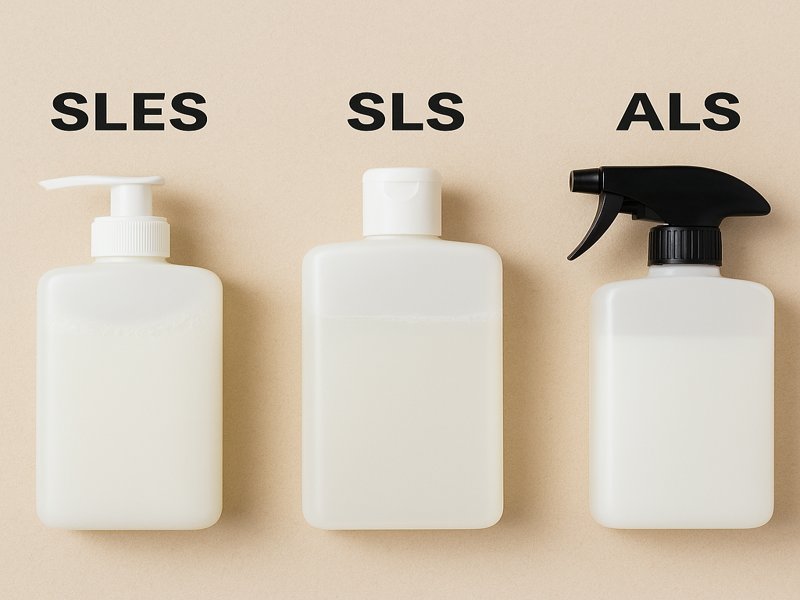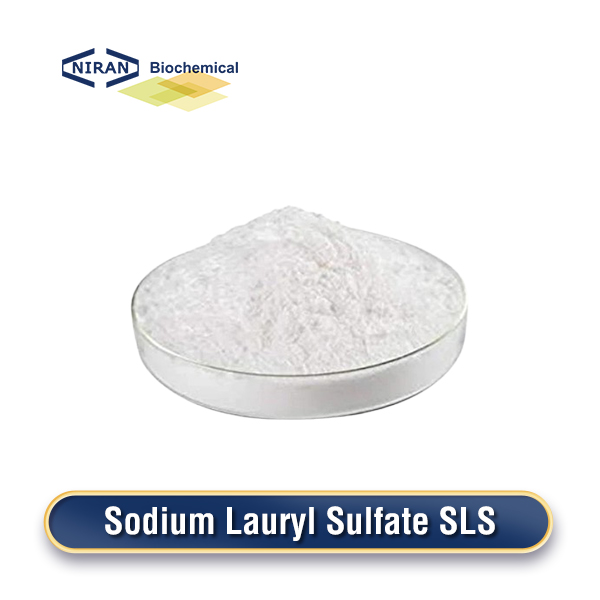Surfactants are key to personal care and cleaning products, helping them lather, cleanse, and emulsify. SLES, SLS, and ALS are common anionic surfactants found in shampoos, cleansers, and detergents. Though similar in name and structure, they vary in performance, irritation risk, cost, and environmental impact.
Understanding the Chemistry of SLES, SLS, and ALS
To compare these surfactants effectively, it’s essential to begin with their chemical identity.
- Sodium Lauryl Sulfate (SLS) is a strong anionic surfactant composed of a 12-carbon tail (lauryl) and a sulfate group. It is frequently found in toothpastes and home cleaners because of how well it removes grease and dirt.
- Sodium Lauryl Ether Sulfate (SLES) is derived from SLS but includes ethylene oxide units (usually 1-3 moles) between the lauryl group and the sulfate group. These ethoxylated chains reduce their irritation potential while maintaining good foaming and cleansing performance.
- Ammonium Lauryl Sulfate (ALS) is chemically similar to SLS, except it has ammonium ions instead of sodium ions. This subtle difference affects solubility and skin tolerance.
Structural Comparison:
| Surfactant | Chemical Formula | Key Features |
| SLS | C12H25SO4Na | Non-ethoxylated, strong cleanser |
| SLES | C12H25(OCH2CH2)nOSO3Na | Ethoxylated (n=1–3), milder than SLS |
| ALS | C12H25SO4NH4 | Ammonium salt, better solubility |
Foaming and Cleansing Performance
Foam is not necessarily indicative of cleaning power, but consumers still associate abundant lather with product quality. All three surfactants offer good foaming properties, though with slight differences:
- SLS: Known for producing rich, dense foam and powerful oil-removal capacity, SLS offers superior detergency but can be too harsh for sensitive applications.
- SLES: Provides softer, creamier foam that feels gentler on skin and hair. The addition of ethylene oxide units reduces its aggressiveness while preserving good cleansing.
- ALS: Also produces decent foam, but tends to be less dense and shorter-lived than that from SLS or SLES. However, its mildness makes it a good candidate for products marketed as gentle or natural.
If foam volume and quick rinsing are top priorities (e.g., in shampoos or face washes), SLES often strikes the best balance.
Irritation and Skin Sensitivity
One of the most discussed differences among SLES, SLS, and ALS lies in skin irritation potential, especially for daily-use products.
- SLS is known to be the harshest among the three. In sensitive users, it may cause dryness, redness, or even allergic responses by removing natural oils.
- SLES, being ethoxylated, is significantly less irritating than SLS. It retains strong cleansing properties without being too aggressive, which is why it’s frequently found in baby shampoos and sensitive-skin formulations.
- ALS falls somewhere in between. While less irritating than SLS, it is typically considered a bit more irritating than SLES.
Summary of Skin Tolerance:
| Surfactant | Irritation Level | Suitable for Sensitive Skin? |
| SLS | High | No |
| SLES | Low | Yes |
| ALS | Moderate | Sometimes |
For facial cleansers and baby care products, SLES is usually the most appropriate choice.
Environmental Considerations
Environmental sustainability is now a core concern for formulators and consumers alike. So, how do SLES, SLS, and ALS stack up?
- SLS is biodegradable, but its high toxicity to aquatic life in concentrated form and production via petrochemicals is a concern.
- SLES, despite being derived from SLS, goes through an ethoxylation process that raises environmental red flags due to the use of ethylene oxide and possible contamination with 1,4-dioxane, a potential carcinogen. However, reputable suppliers offer low-dioxane versions.
- ALS is generally seen as environmentally friendlier than SLES due to better biodegradability and the absence of ethoxylation byproducts.
If environmental profile is a priority (e.g., for green or organic labels), ALS is a favorable choice, though cost and performance trade-offs should be considered.
Cost and Supply Chain Factors
Price is always a factor, especially for mass-produced products.
- SLS is the cheapest of the three and has broad global availability. It is widely used in budget products, industrial cleaners, and toothpaste.
- SLES, being ethoxylated and requiring more processing, is moderately priced. Still, it offers good performance for the cost, making it the go-to surfactant for mid-tier and premium personal care products.
- ALS is typically the most expensive of the three and can have less consistent global availability, depending on your chemical supplier.
For cost-sensitive formulations, SLS may still be used in low concentrations combined with other milder agents. For higher-end products, SLES delivers better consumer satisfaction per dollar.
Product Suitability by Application
Different personal and household care products demand different surfactant profiles. Here’s a breakdown:
| Application | Best Surfactant | Reason |
| Shampoo | SLES | Gentle on scalp, good foam |
| Baby wash | SLES | Lowest irritation |
| Facial cleanser | ALS/SLES | Mild with enough cleansing |
| Dishwashing liquid | SLS | High oil-removal power |
| Industrial cleaner | SLS | Strong degreasing needed |
| Natural products | ALS | No ethoxylation, better green profile |
| Toothpaste | SLS | Strong foaming, effective for plaque removal |
Combining SLES with co-surfactants like Cocamidopropyl Betaine can further reduce irritation and enhance foam quality.
Regulatory and Labeling Considerations
Due to concerns about sulfates in general, consumer awareness has grown around the potential negative effects of SLS and SLES. This has led to a trend of “sulfate-free” labels, even though ALS is technically a sulfate, too.
Key notes:
- Products with SLS or SLES may face consumer resistance unless clearly formulated for performance.
- SLES with low 1,4-dioxane content can be marketed as safe and gentle.
- ALS, despite being a sulfate, is less commonly scrutinized and can be labeled as “gentle.”
If your branding strategy includes “clean beauty” or “non-toxic” claims, ALS or non-sulfate surfactants like glucosides might be better alternatives.
Emerging Alternatives to Traditional Sulfates
Although SLES, SLS, and ALS still dominate, newer surfactants like Sodium Cocoyl Isethionate, Disodium Laureth Sulfosuccinate, and Decyl Glucoside are gaining popularity due to their extreme mildness, biodegradability, and favorable public image.
However, these alternatives often come with:
- Higher costs
- Lower foam production
- Limited compatibility with traditional emulsifiers
Which Surfactant Is the Best?
- Choose SLS if your priority is cost-effectiveness and strong cleaning, and your product is not meant for sensitive skin.
- Choose SLES if you need a well-balanced surfactant with good foam, low irritation, and reasonable cost—ideal for most personal care applications.
- Choose ALS if your brand emphasizes environmental sustainability, mildness, and sulfate-conscious consumers, even if it costs more.
For most modern personal care products, SLES is the most recommended surfactant due to its synergy between gentleness and performance, while ALS serves niche markets, and SLS remains relevant in industrial and high-detergency needs.



